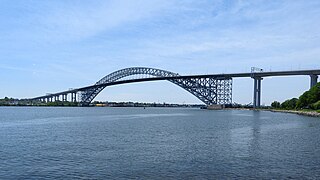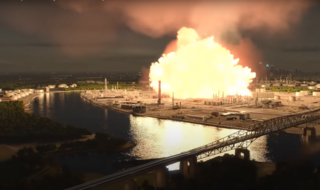
The Verrazzano-Narrows Bridge, also referred to as the Narrows Bridge, the Verrazzano Bridge, and simply the Verrazzano, is a suspension bridge connecting the New York City boroughs of Staten Island and Brooklyn. It spans the Narrows, a body of water linking the relatively enclosed New York Harbor with Lower New York Bay and the Atlantic Ocean. It is the only fixed crossing of the Narrows. The double-deck bridge carries 13 lanes of Interstate 278: seven on the upper level and six on the lower level. The span is named for Giovanni da Verrazzano, who in 1524 was the first European explorer to enter New York Harbor and the Hudson River.

The Staten Island Ferry is a fare-free passenger ferry route operated by the New York City Department of Transportation. The ferry's single route runs 5.2 miles (8.4 km) through New York Harbor between the New York City boroughs of Manhattan and Staten Island, with ferry boats making the trip in about 25 minutes. The ferry operates 24 hours a day, 7 days a week, with boats leaving every 15 to 20 minutes during peak hours and every 30 minutes at other times. Apart from NYC Ferry's St. George route, it is the only direct mass-transit connection between the two boroughs. Historically, the Staten Island Ferry has charged a relatively low fare compared to other modes of transit in the area; and since 1997, the route has been fare-free. The Staten Island Ferry is one of several ferry systems in the New York City area and is operated separately from systems like NYC Ferry and NY Waterway.

The Staten Island Railway (SIR) is a rapid transit line in the New York City borough of Staten Island. It is owned by the Staten Island Rapid Transit Operating Authority (SIRTOA), a subsidiary of the Metropolitan Transportation Authority, and operated by the New York City Transit Authority Department of Subways. SIR operates 24 hours a day, seven days a week, providing local service between St. George and Tottenville, along the east side of the island. There is currently only one line on the island, and there is no direct rail link between the SIR and the New York City Subway system, but SIR riders do receive a free transfer to New York City Transit bus and subway lines, and the line is included on official New York City Subway maps. Commuters on the railway typically use the Staten Island Ferry to reach Manhattan. The line is accessible from within the Ferry Terminal, and most of its trains are timed to connect with the ferry. In 2023, the system had a ridership of 6,151,400, or about 19,500 per weekday as of the fourth quarter of 2023.

The Metropolitan Transportation Authority (MTA) is a public benefit corporation responsible for public transportation in the New York City metropolitan area of the U.S. state of New York. The MTA is the largest public transit authority in North America, serving 12 counties in Downstate New York, along with two counties in southwestern Connecticut under contract to the Connecticut Department of Transportation, carrying over 11 million passengers on an average weekday systemwide, and over 850,000 vehicles on its seven toll bridges and two tunnels per weekday.

The Bayonne Bridge is an arch bridge that spans the Kill Van Kull between Staten Island, New York and Bayonne, New Jersey. It carries New York State Route 440 and New Jersey Route 440, with the two roads connecting at the state border at the river’s center. It has the sixth-longest steel arch mainspan in the world, and this span was the longest in the world at the time of its completion. The bridge is also one of four connecting New Jersey with Staten Island; the other two roadway bridges are the Goethals Bridge in Elizabeth and Outerbridge Crossing in Perth Amboy, and the rail-only span is the Arthur Kill Vertical Lift Bridge, all of which cross the Arthur Kill.

A boiling liquid expanding vapor explosion is an explosion caused by the rupture of a vessel containing a pressurized liquid that is or has reached a temperature sufficiently higher than its boiling point. Because the boiling point of a liquid rises with pressure, the contents of the pressurized vessel can remain a liquid as long as the vessel is intact. If the vessel's integrity is compromised, the loss of pressure drops the boiling point, which can cause the liquid to convert to gas expanding rapidly. BLEVEs are manifestations of explosive boiling.

Liquefied natural gas (LNG) is natural gas (predominantly methane, CH4, with some mixture of ethane, C2H6) that has been cooled down to liquid form for ease and safety of non-pressurized storage or transport. It takes up about 1/600th the volume of natural gas in the gaseous state at standard conditions for temperature and pressure.
Samuel Irving "S.I." Newhouse Jr. was an American heir to a substantial magazine and media business. Together with his brother Donald, he owned Advance Publications, founded by their late father in 1922, whose properties include Condé Nast, dozens of newspapers across the United States, former cable company Bright House Networks, and a controlling stake in Discovery Communications.
West Shore refers to the section of the New York City borough of Staten Island that borders the Arthur Kill, between the Staten Island Expressway and the Fresh Kills. The Arthur Kill shoreline north of the expressway—most commonly called Port Ivory—is considered part of the North Shore, while the land along the Arthur Kill south of Fresh Kills is generally included within the South Shore.
Bloomfield is the name of a neighborhood on the West Shore of the New York City borough of Staten Island. It lies immediately to the north of Travis-Chelsea and to the west of Bulls Head. Prall's Island is situated in the Arthur Kill off its coast.
The Chemical Coast is a section of Union and Middlesex counties in New Jersey located along the shores of the Arthur Kill, across from Staten Island, New York. The name is taken from the Conrail Chemical Coast Line, an important component in the ExpressRail system serving marine terminals in the Port of New York and New Jersey.
Texas Eastern Pipeline (TETCo) is a major natural gas pipeline which brings gas from the Gulf of Mexico coast in Texas and Louisiana up through Mississippi, Arkansas, Tennessee, Missouri, Kentucky, Illinois, Indiana, Ohio, and Pennsylvania to deliver gas in the New York City area. It is one of the largest pipeline systems in the United States. It is owned by Enbridge. Its FERC code is 17.

The Bay Ridge–95th Street station is the southern terminal station on the BMT Fourth Avenue Line of the New York City Subway. Despite the name, the station is located in the neighborhood of Fort Hamilton at the intersection of 95th Street and Fourth Avenue in southwestern Brooklyn. It is served by the R train at all times. Geographically, this station is the westernmost New York City Subway station.

St. George Terminal is a ferry, railway, bus, and park and ride transit center in the St. George neighborhood of Staten Island, New York City. It is located at the intersection of Richmond Terrace and Bay Street, near Staten Island Borough Hall, SIUH Community Park and Richmond County Supreme Court. St. George is a rare example of a rail-boat connection in the United States.
The 1984 Tbilisi gas explosion was a natural gas explosion in a nine-story apartment block in Tbilisi, Georgia on 2 December 1984 that killed at least 100 people. Utility workers were investigating complaints of a gas leak when the explosion occurred. A broadcast on Georgian television said that 35 families had been affected by the explosion.

The Whitehall Terminal is a ferry terminal in the South Ferry section of Lower Manhattan, New York City, at the corner of South Street and Whitehall Street. It is used by the Staten Island Ferry, which connects the island boroughs of Manhattan and Staten Island. The Whitehall Terminal is one of the ferry's two terminals, the other being St. George Terminal on Staten Island.
An explosion at the ARCO Chemical (ACC) Channelview, Texas petrochemical plant killed 17 people and injured five others on July 5, 1990. It was one of the deadliest industrial disasters in the history of the Greater Houston area.










